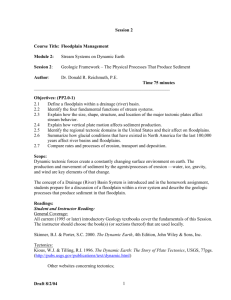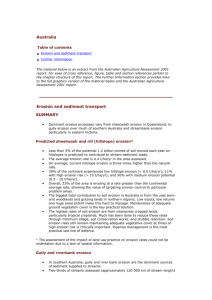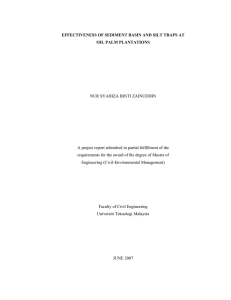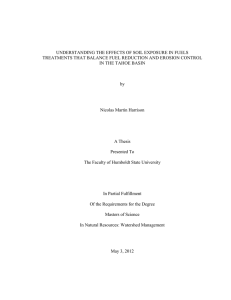Class Pre-reading Definitions
advertisement
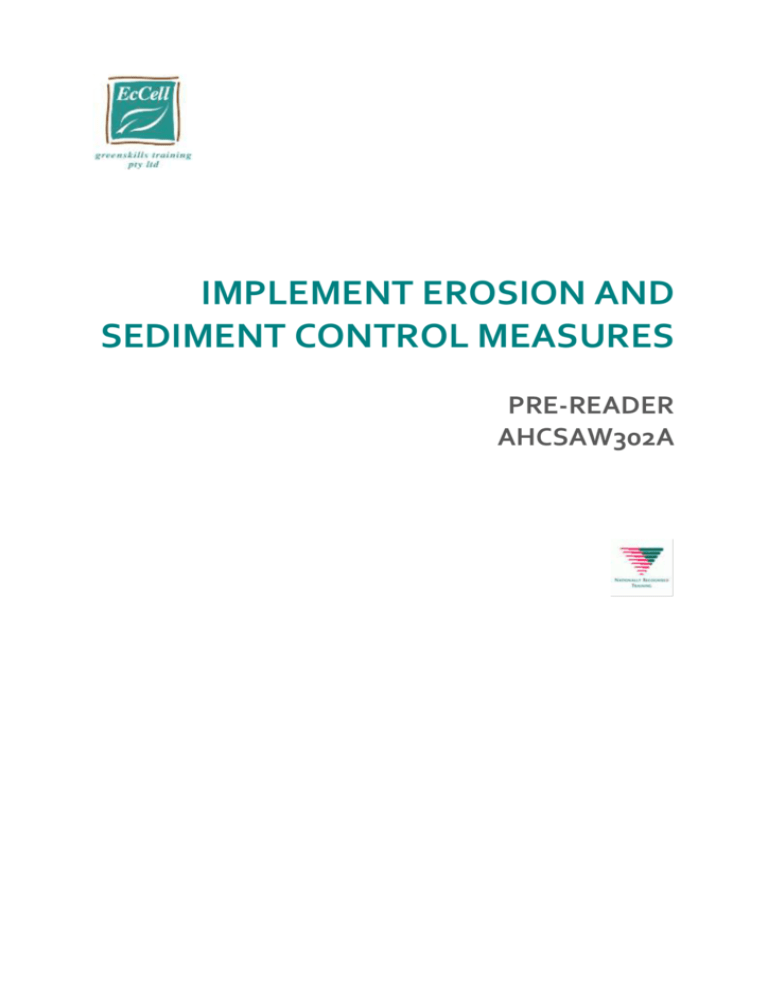
IMPLEMENT EROSION AND SEDIMENT CONTROL MEASURES PRE-READER AHCSAW302A Class Pre-Reader Version 1 Copyright © EcCell Greenskills Training Pty Ltd 2013 This work is copyright apart from any use as permitted under the Copyright Act 1968, no part may be reproduced by any process without written agreement from the publisher. Requests and enquiries concerning reproduction and rights should be made to: The Director EcCell Greenskills Training Pty Ltd 35 Waverley Crescent Bondi Junction NSW 2022 Telephone: (02) 9369 1799 Class Pre-Reader EC AHCSAW302A PR Implement erosion and sediment control measures Version 1 91563NSW Certificate IV Environmental Management and Sustainability © EcCell Greenskills Training Pty Ltd. 2013 Dated 28.08.12 Printed 02.03.13 2 Class Pre-reading Definitions The pre reading provides definitions An impediment to surface water placed on or near a contour along the surface to be Barrier protected (slopes or channels). Barriers can also be used to divert surface water flow to a stabilised outlet. Various materials can be used depending upon the quantity and depth of water and local availability of materials. Common materials include brush, compacted earth, gravel, hay, rock, sand bags, silt fences and straw bales. Basin A hollow or depression within which water can be contained. Batter The side-slope of an embankment or cutting. Biodiversity The number of species of vegetation and wildlife in a given habitat. Rainforests, which typically have many different plant and animal species, are said to be “high” in biodiversity. Catch drain A small channel constructed to intercept and divert runoff away from embankments, disturbed areas, and stockpiles Clay A natural earthy material possessing plastic properties and consisting of particles finer than 0.002 mm. Generally, it includes the most chemically active mineral part of a soil. Many of the important physical and chemical properties of a soil depend on the type and quantity of the clay portion. Detention basin (retention/retarding basin) – A storage pond, basin or tank used to reduce and attenuate the peak discharge within a drainage system Dispersible soils Dispersible soils are structurally unstable in water and readily split into their constituent fine particles resulting in turbid water that never seems to clear. They can stay in suspension for very long periods, mainly because of negative electrical charges on their surfaces that cause them to repel each other. Diversion bank An earth bank constructed across a slope for intercepting and diverting water. Typically constructed at the upper edges of cut slopes to collect water from nearby properties and divert it around the cut. Due diligence Due diligence is the only real defense to prosecution proceedings for environmental mishaps. It is based on a systematic approach to setting environmental performance standards. Class Pre-Reader EC AHCSAW302A PR Implement erosion and sediment control measures Version 1 91563NSW Certificate IV Environmental Management and Sustainability © EcCell Greenskills Training Pty Ltd. 2013 Dated 28.08.12 Printed 02.03.13 3 Erosion Detachment and movement of soil or rock fragments by water, wind, ice or gravity (i.e. accelerated, geological, gully, natural, rill, sheet, splash, or impact, etc.) Erosion and Sediment Control Plan An Erosion and Sediment Control Plan is a component of a Soil and Water Management Plan, but only addresses erosion and sediment control during a construction phase where 250 to 2,500 square metres will be disturbed It does not address ongoing or permanent control of pollutants (c.f. Soil and Water Management Plan). Flocculent A chemical agent used to enhance the flocculation process (c.f. flocculation) Geofabric filter fabric, geotextile) – (1) A synthetic fabric, woven or non woven, used for various purposes including: Soil pH is a measure of the acidity or alkalinity of a soil. It relates to the concentration of the hydrogen ions (H+) in the soil solution measured on a negative logarithmic scale of 1 to 14. The concentrations of hydrogen ions are equal to the hydroxyl ions (OH–) at pH 7, greater below pH 7 (acid) and fewer above (alkaline). Sediment basin A basin or tank in which storm water containing settleable solids is retained to remove by gravity or filtration a part of the suspended matter. Sedimentation Deposition of material of varying size, both mineral and organic, away from its site of origin by the action of water, wind, gravity or ice. Topsoil The top layers of soil that supports vegetation. Tunnel erosion – The removal of subsoil by water while the surface remains relatively intact; also called piping There are four basic principles in managing stormwater (i) Make sure everyone working on the site understands how important it is to not pollute stormwater (or sewer). (ii) Do not disturb more of the site than you have to. (iii) Install erosion and sediment controls before starting work. (iv) Maintain your erosion and sediment control works throughout the construction phase* (MUSSC). Class Pre-Reader EC AHCSAW302A PR Implement erosion and sediment control measures Version 1 91563NSW Certificate IV Environmental Management and Sustainability © EcCell Greenskills Training Pty Ltd. 2013 Dated 28.08.12 Printed 02.03.13 4






